How to fight aphids on cucumbers: the best folk remedies
Aphids are considered one of the most malicious and voracious pests. If measures are not taken in time to destroy the insect, it will cause serious damage to the future harvest. It is not always safe to use professional insecticides in the garden, so farmers use proven home remedies.
We will tell you in the article how to fight aphids on cucumbers using folk remedies based on mustard, vinegar and other available substances.
Who are aphids and how are they dangerous for cucumbers?
Cotton, or melon, aphid (Aphis gossypii) - insects from the order Hemiptera, polyphagous and cosmopolitan. It is characterized by an incompletely cyclic type of development and is found everywhere. A dangerous pest of cultivated plants, a carrier of bacteria and viruses.
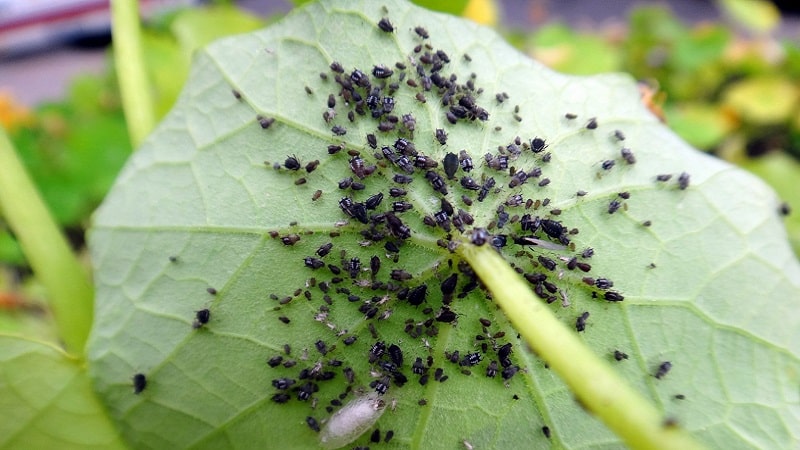
Insects feed on plant juices and, when widespread, cause irreparable damage to the crop. Aphids' favorite delicacy is juicy cucumber leaves. Loss of moisture leads to delayed plant development, wilting, and the appearance of fruits later than expected.
Aphids attacking cucumbers
cucumbers in the greenhouse and the garden is amazed by the green and black aphid. Small bugs are no more than 5 mm in length - and these are the largest individuals. The standard size of an insect is 2-3 mm. The soft body is covered with growths and hairs. On the forehead there are antennae with organs of touch. The mouthparts are in the form of a proboscis, with which the insect pierces the leaves and draws out the juice. Insects walk and jump on long and thin legs.On the abdomen there are juice tubes through which a sticky liquid is secreted - honeydew.
Aphids have excellent adaptation abilities to terrain and climate. Larvae and wingless virgins overwinter in the upper layers of the soil.
Reference. Females reproduce extremely quickly. In summer they lay about 50 eggs at a time.
Insect colonies concentrate mainly on the upper tender foliage. The lower leaves have a too dense structure, which is too tough for aphids. In spring, at an air temperature of +5°C, aphids begin to attack young cucumber plantings. By sucking plant sap, aphids secrete poison that causes foliage to curl, deform, and die.
Honeydew contaminates the surface of the leaves and disrupts the normal functioning of the plant. Another danger of aphids for cucumbers is infection with viruses through saliva.
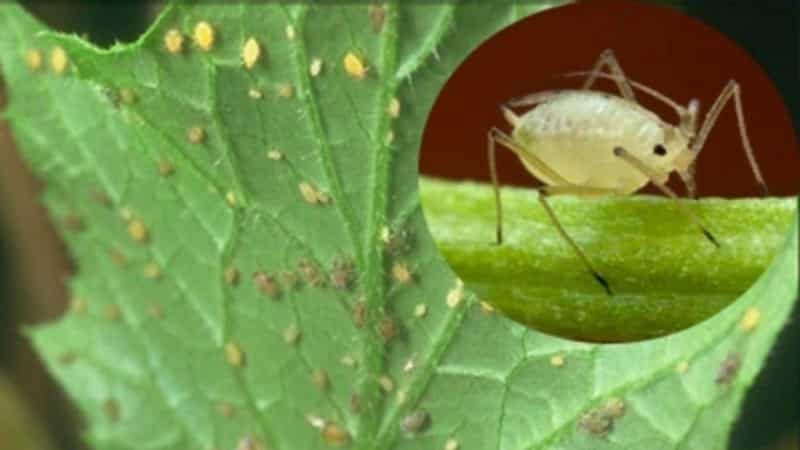
Signs of defeat
At the beginning of the season, it is quite difficult to see small green bugs merging with the green mass. However As the pest spreads, the first signs appear:
- delayed growth and development of cucumbers;
- delayed flowering;
- wilting of the upper foliage;
- curling and drying of leaves;
- honeydew on greens;
- accumulation of ants on the site;
- falling of flower ovaries;
- wilting of the lower leaves;
- black or green bugs on the back of leaves.
Causes of aphids
One of the main reasons for the appearance aphids on the site - ants. They are attracted to the sweet and sticky honeydew on the leaves. This is honeydew - a secretion secreted by aphids. Moving around the site, ants act as “carriers”. They carry bugs on themselves, infecting new plantings.
Reference. Some ant species protect aphid colonies from natural pests and graze them as pets.
Failure to follow the rules for caring for cucumbers (loosening the soil and removing weeds), dense planting, poor ventilation in the greenhouse, and excess nitrogen in the soil contribute to the appearance of aphids.
Basic methods of struggle
Fighting aphids on cucumbers requires effort, especially in conditions of rapid population growth. Chemical agents of contact-intestinal action are the most effective. They are used before flowering, since aggressive substances accumulate in flower ovaries, fruits and roots. Consumption of such a product by humans is hazardous to health.
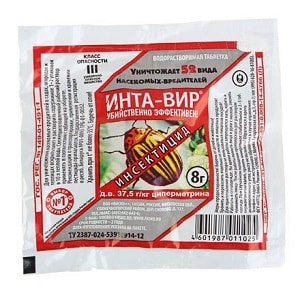 Insecticides are available in the form of powder, tablets and liquid. The substances have a nerve-paralytic effect. The chemicals “Decis”, “Inta-Vir”, “Aktara”, “Tanrek”, “Danadim”, “Konfidor” are popular among gardeners.
Insecticides are available in the form of powder, tablets and liquid. The substances have a nerve-paralytic effect. The chemicals “Decis”, “Inta-Vir”, “Aktara”, “Tanrek”, “Danadim”, “Konfidor” are popular among gardeners.
Biological products are no less effective against aphids — “Bitoxibacillin”, “Aquarin”, “Aktofit”, “Fitoverm”, “Entobacterin”, “Strela”. They are allowed to be used during the fruiting period. The substances do not accumulate in plant tissues and are completely harmless to humans. Penetrating the digestive system, they deprive the insect of the opportunity to feed, causing starvation. The products do not cause addiction in aphids, as happens with chemicals.
Folk remedies based on herbal decoctions and infusions, vinegar, mustard powder, soap, ash, tobacco, ammonia are suitable for use throughout the entire growing season. For better results, it is recommended to alternate and combine them with each other. For example, spraying foliage with garlic infusion is combined with treatment with a solution of mustard powder.
Attention! The action of folk remedies is not aimed at physically destroying the pest, but at repelling it.
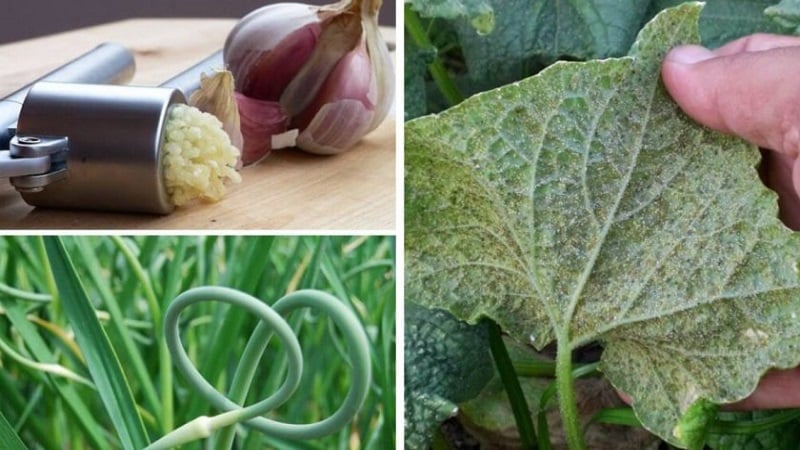
Traditional methods of pest control in greenhouses and open ground
The table contains effective folk recipes for removing aphids. The treatment is carried out in the evening, after sunset, so that the sun's rays do not burn the leaves. The products are suitable for spraying cucumbers in greenhouses and in open ground.
| Name | Preparation and use |
| Marigold | Fill the bucket halfway with dried flowers, add water at room temperature. Leave for two days, strain through cheesecloth and dissolve 40-50 g of soap shavings. Treatment is carried out once every 7 days. |
| Yarrow | 400 g of raw materials per 1 liter of boiling water. Leave for 2 hours and increase the volume to 10 liters. Spray leaves on both sides once every 10 days. |
| Chamomile | 1 kg of pharmaceutical chamomile per 10 liters of water. Leave for 5-6 hours and strain through cheesecloth. Treat bushes once a week. |
| Celandine | 250 g of dry raw materials per 10 liters of water. Leave for two days, strain. Spray the bushes once a week. |
| Mustard | 50 g of mustard beans per 5 liters of water. Leave for 48 hours, add 5 liters of water and treat the plantings. The frequency of spraying is 2 times every 10 days. |
| Dandelion roots | 1 kg of dry raw materials per 10 liters of water. Leave for 3 hours and process the leaves. Spraying frequency: 1 time per week. |
| Tomato and potato tops | 500 g of green tops per 10 liters of water. Simmer over low heat for 30 minutes. Cool, strain, rub in 25 g of liquid soap. Spray the leaves from below and above once a week. |
| Hot peppers | Take 3 pods for 10 liters of water. Leave for 24 hours in a warm place, strain and mix in 50 g of soap shavings, 100 g of wood ash, 3-5 drops of iodine. Treatment frequency: 1 time every 10 days. |
| Horse sorrel | 300 g of crushed plant roots and 400 g of dandelion leaves per 10 liters of warm water. Leave for 2-3 hours, spray once every 7 days. |
| Pine extract | Pour 2 kg of pine or spruce needles into 10 liters of water. Leave for 7 days, stirring daily. Before treatment, dilute with water in a ratio of 1:3. Spraying frequency: 1 time every 10 days. To water rows, dilute the concentrate in a 1:1 ratio. |
| Garlic | Pour 500 g of garlic arrows or cloves into 2 liters of warm water. Leave for a week, use to irrigate bushes once every 7 days. |
| Horseradish | Take 10–15 crushed roots for 5 liters of boiling water. Leave for 5 hours, strain through cheesecloth. Pour the cake into 5 liters of clean warm water, after 3 hours add the first concentrate. For spraying, mix 200 ml of concentrated liquid with 5 liters of water and carry out treatment. Frequency: 1 time every 10-12 days. |
| Onion peel | Pour a few handfuls of onion peel into 5 liters of warm water and leave overnight. In the morning, strain and add 25 ml of liquid tar soap.
100 g of onion peel and zest of one lemon per 10 liters of water. Leave for 3 days. Use for spraying plantings once every 10 days. |
| Tobacco shag | 400 g per 10 liters of boiling water. Leave the solution for 2-3 days and mix in 50 g of soap shavings. Treat plantings once a week. |
| Wood ash | 200 g of ash and 200 g of laundry soap shavings per 10 liters of water. Leave for 3 hours and treat the bushes. Frequency: 1 time per week. |
| Soap solution | Grate 2 pieces of laundry or tar soap and dissolve in 10 liters of warm water. Treat leaves once every 7-10 days. |
| Soda | Dissolve 200 g of baking soda in 5 liters of water, add 20 drops of cedar essential oil and process. Frequency: 1 time every 10 days. |
| Whey (kefir) | Cucumbers are treated daily until the aphids completely disappear. |
| Ammonia | 2 tbsp. l. for 5 liters of water, add 20 ml of tar liquid soap. Treat leaves on both sides once every 10 days. |
| Vinegar | 100 ml of 9% vinegar, 50 g of laundry soap shavings per 10 liters of water. Spray the plants once a week. |
| Vodka | Pour alcohol into a spray bottle and spray the bushes. According to gardeners, the product acts instantly. |
| Coca Cola | Pour the drink into a spray bottle and spray the plantings. The destructive effect on aphids is explained by the content of orthophosphoric acid. |
| Sunflower oil | Mix 200 ml of oil with 1 liter of water and immediately spray the cucumbers. Frequency: 3 times per season. |
Insects are natural enemies of aphids
Praying mantises, ladybugs, wasps, lacewings, hoverflies, ground beetle larvae, earwigs, bugs are natural enemies of aphids. To attract beneficial insects to the site, marigolds, oregano, daisies, caraway seeds, fragrant dill, chamomile, dandelions, coltsfoot, parsley, celery, and mint are planted next to cucumbers.
Advice. To attract ladybugs, hang insect houses. You can purchase them at gardening stores or build them yourself from old logs by drilling holes in them.
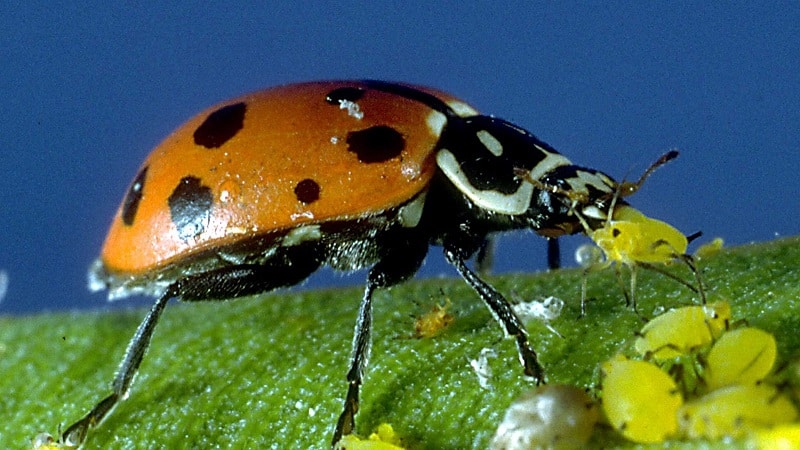
Prevention measures
Preventive measures:
- mosquito nets on the windows in the greenhouse;
- covering the beds with agrofibre;
- killing or repelling ants;
- removal of weeds and plant residues;
- treating seeds in a solution of potassium permanganate or “Fitosporin”;
- soil disinfection with copper sulfate;
- treatment of greenhouse premises with sulfur bombs;
- alternating means for treating plantings to prevent insect resistance;
- crop rotation;
- sparse landing;
- selection of varieties resistant to aphid attacks;
- fertilizing cucumbers with organic matter and minerals.
Conclusion
The fight against aphids on cucumbers is complicated by lightning-fast natural reproduction in favorable conditions.The farmer’s main task is to begin processing the crops faster than the pest destroys the crop.
Plant-based folk remedies are used throughout the growing season. Solutions and infusions are completely safe for humans and the environment, unlike chemicals, the use of which is permitted until flowering. An integrated approach using agricultural techniques and spraying of plantings allows you to quickly get rid of the pest.